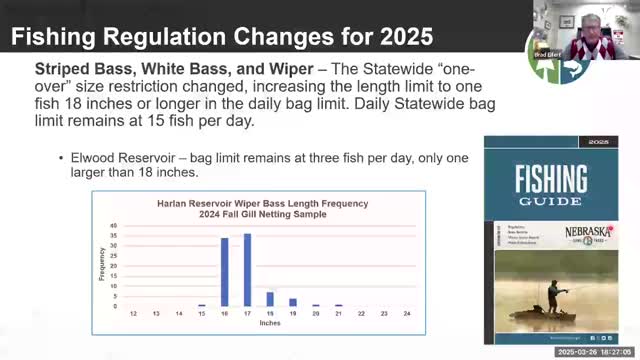Nebraska officials raise wiper fish size limit to 18 inches for enhanced angler opportunities
January 01, 2025 | Nebraska Game and Parks Commission (NGPC), State Agencies, Organizations, Executive, Nebraska
This article was created by AI summarizing key points discussed. AI makes mistakes, so for full details and context, please refer to the video of the full meeting. Please report any errors so we can fix them. Report an error »

The Nebraska South-Central District Fisheries Meeting held on January 1, 2025, focused on several key topics impacting local fisheries and aquatic ecosystems. The discussions highlighted the management strategies for wiper populations, reservoir conditions, and ongoing research initiatives, all of which are crucial for maintaining healthy fish habitats and supporting local anglers.
One of the primary topics was the management of wiper fish in Harlan and Southwest Reservoirs. Officials noted a strong year class of wipers, prompting a decision to increase the minimum size limit for harvest from 16 to 18 inches. This change aims to allow anglers an additional year to catch these fish, which grow quickly and typically do not remain under the new limit for long. The meeting emphasized the importance of this adjustment, as it reflects the health of the fish population and aims to enhance angler satisfaction.
Additionally, the meeting addressed the renovation of Buffelhead Wildlife Management Area (WMA), a 15-acre sandpit near Kearney. After observing a decline in the bass population and overall angler satisfaction, officials decided to renovate the area. The renovation revealed a concerning ratio of rough fish to sport fish, with 285 pounds of rough fish per acre compared to only 35 pounds of sport fish. This renovation is expected to improve the ecosystem, with plans to restock the area with smallmouth bass, yellow perch, and black crappie in the spring.
Reservoir levels were another significant point of discussion. Most reservoirs in the South-Central District, such as Davis Creek and Sherman, are expected to remain stable due to consistent water supply from feeder canals. However, concerns were raised about Harlan Reservoir, which is currently down about seven feet from full pool. The reliance on precipitation in the Republican River Basin for water supply poses risks for the reservoir's levels, potentially affecting access for boaters and anglers if conditions do not improve.
The meeting also touched on ongoing research projects, including a cove evaluation project in Harlan in collaboration with the University of Nebraska at Kearney, and a statewide study on largemouth bass. These research efforts aim to gather data that will inform future management decisions and enhance the sustainability of fish populations.
Lastly, the discussion included updates on the state's aquatic invasive species program. With a dedicated team managing inspections and monitoring, officials encouraged anglers to cooperate with watercraft inspections and report any unusual species they encounter. This proactive approach is vital for protecting Nebraska's aquatic ecosystems from invasive threats.
In conclusion, the Nebraska South-Central District Fisheries Meeting underscored the importance of adaptive management strategies in fisheries, the need for ongoing research, and the commitment to maintaining healthy aquatic environments. As the season progresses, stakeholders will be closely monitoring reservoir conditions and fish populations to ensure sustainable fishing opportunities for the community.
One of the primary topics was the management of wiper fish in Harlan and Southwest Reservoirs. Officials noted a strong year class of wipers, prompting a decision to increase the minimum size limit for harvest from 16 to 18 inches. This change aims to allow anglers an additional year to catch these fish, which grow quickly and typically do not remain under the new limit for long. The meeting emphasized the importance of this adjustment, as it reflects the health of the fish population and aims to enhance angler satisfaction.
Additionally, the meeting addressed the renovation of Buffelhead Wildlife Management Area (WMA), a 15-acre sandpit near Kearney. After observing a decline in the bass population and overall angler satisfaction, officials decided to renovate the area. The renovation revealed a concerning ratio of rough fish to sport fish, with 285 pounds of rough fish per acre compared to only 35 pounds of sport fish. This renovation is expected to improve the ecosystem, with plans to restock the area with smallmouth bass, yellow perch, and black crappie in the spring.
Reservoir levels were another significant point of discussion. Most reservoirs in the South-Central District, such as Davis Creek and Sherman, are expected to remain stable due to consistent water supply from feeder canals. However, concerns were raised about Harlan Reservoir, which is currently down about seven feet from full pool. The reliance on precipitation in the Republican River Basin for water supply poses risks for the reservoir's levels, potentially affecting access for boaters and anglers if conditions do not improve.
The meeting also touched on ongoing research projects, including a cove evaluation project in Harlan in collaboration with the University of Nebraska at Kearney, and a statewide study on largemouth bass. These research efforts aim to gather data that will inform future management decisions and enhance the sustainability of fish populations.
Lastly, the discussion included updates on the state's aquatic invasive species program. With a dedicated team managing inspections and monitoring, officials encouraged anglers to cooperate with watercraft inspections and report any unusual species they encounter. This proactive approach is vital for protecting Nebraska's aquatic ecosystems from invasive threats.
In conclusion, the Nebraska South-Central District Fisheries Meeting underscored the importance of adaptive management strategies in fisheries, the need for ongoing research, and the commitment to maintaining healthy aquatic environments. As the season progresses, stakeholders will be closely monitoring reservoir conditions and fish populations to ensure sustainable fishing opportunities for the community.
View full meeting
This article is based on a recent meeting—watch the full video and explore the complete transcript for deeper insights into the discussion.
View full meeting
